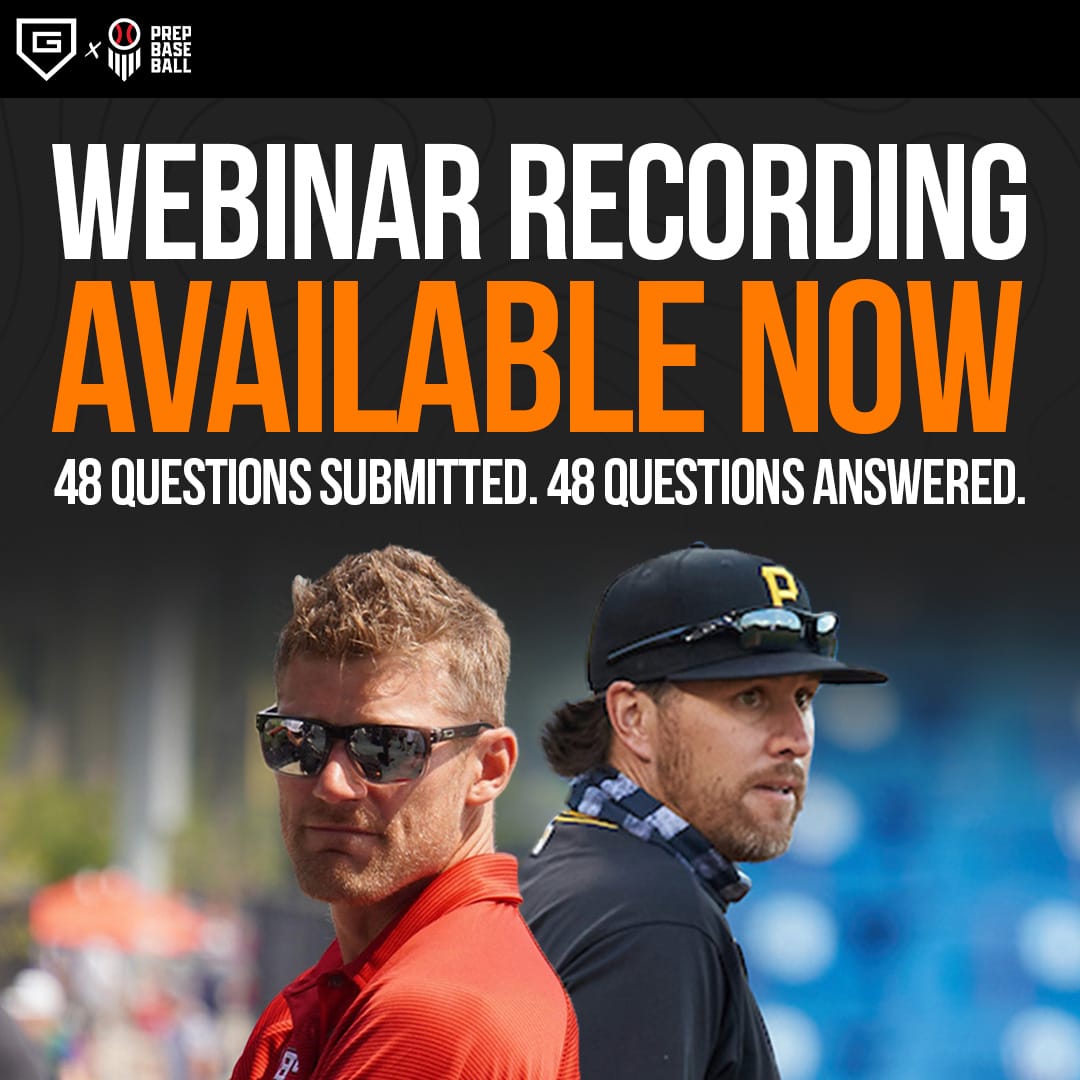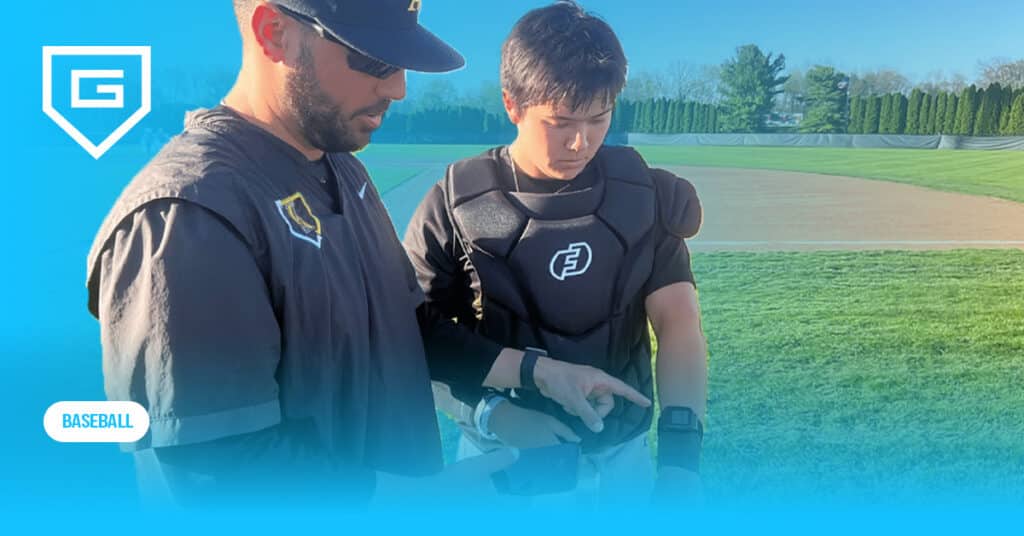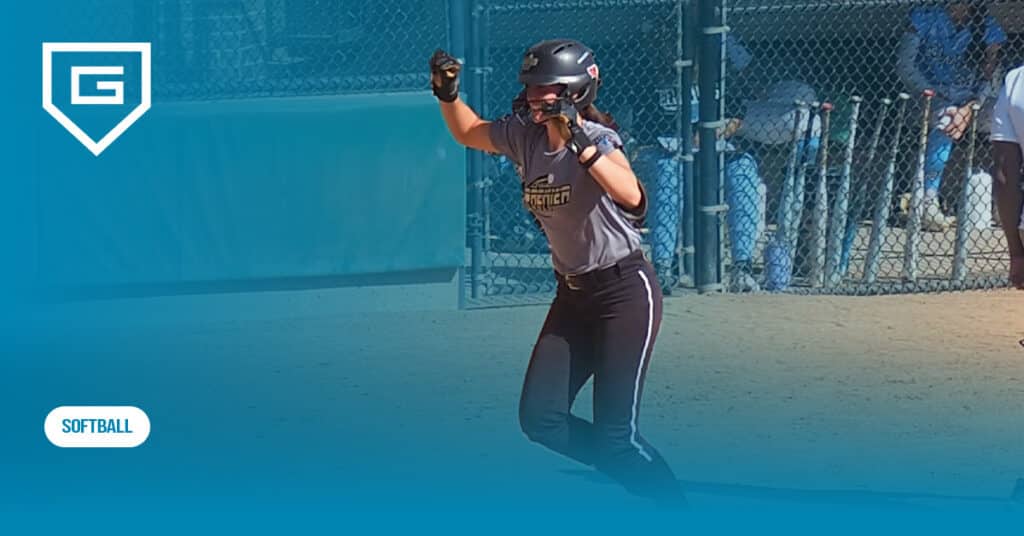Baseball Pitch Grips: The Ultimate Guide For Players & Coaches
Reading Time: 21 minutes
Reading Time: 21 minutes
Baseball pitch grips set the foundation for every pitcher’s arsenal. New pitchers often start with a basic fastball grip. To be effective on the mound and keep hitters on their toes, you typically need more than one pitch.
There’s a wide selection of pitch grips – ranging from a basic four-seam fastball to specialty pitches like a knuckleball. Because all baseballs are designed to a specific standard, the way a pitcher grips the ball impacts its spin direction, trajectory, and velocity. Finger positioning, pressure, depth, and dexterity determine the flight path of a pitch.
You can alter the grip of any pitch, making small changes to affect movement and speed. Understanding not just how but why you grip the baseball a certain way is key to becoming a strategic, effective pitcher.
When learning new pitch grips, practice and baseball pitching drills are essential. You don’t have to be on the mound to practice. Pick up a ball whenever you have spare time at home (or anywhere else) and practice new grips. Use a mirror to mimic your motion and release. As a coach, it’s important to set aside time in your baseball practice plans to work on grips with your pitching staff.
This ultimate guide will teach you:
- Different types of pitch grips
- How to hold them
- Grip variations, and
- How to use them in game settings
Different Types of Baseball Pitch Grips
A few different types of pitches are commonly taught to young players and new pitchers. When you reach the high school, college, and professional levels of baseball, you’ll see an expanded variation of pitch grips and pitch types.
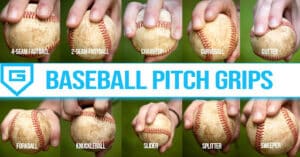
You can break most pitch grips into three categories: fastballs, off-speed pitches, and breaking balls.
There’s overlap between the categories at times, but the different types of baseball pitch grips include:
- Fastballs
- Four-seam fastball
- Two-seam fastball (or sinker)
- Cutter
- Off-speed pitches and breaking balls
- Changeup
- Curveball
- Slider
- Slurve
- Sweeper
- Splitter
- Forkball
- Knuckleball
How To Grip Common Baseball Pitches
Four-Seam Fastball
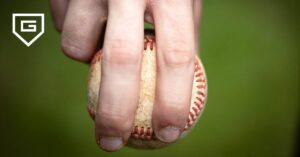
A four-seam fastball is the most basic baseball pitch grip and the first to teach young players new to pitching.
Because there is little movement, command and velocity is the key to an effective four-seam fastball. A powerful, precise four-seamer serves as the core of a pitcher’s arsenal.
How to grip a four-seam fastball
- Place your index and middle fingers perpendicular across the c-shaped “horseshoe” with your fingertips slightly overtop the seams.
- For a basic four-seam fastball grip, your index and middle fingers are spread apart slightly. There should be roughly half-an-inch to an inch – about a finger’s width – of separation between the two.
- Your index and middle fingers have four points of contact with the “horseshoe” seam – the top of each finger touches the upper seam and the bottom of each finger touches the lower seam.
- Place your thumb beneath the ball, resting against the bottom seam directly underneath your index and middle fingers.
- Your ring and pinky fingers rest lightly tucked on the outside of the baseball.
- Hold the ball with a relaxed grip to achieve maximum velocity. Your grip should be firm enough that you have control, but loose enough that you don’t choke it.
- Keep the ball in your fingers. Gripping with your palm – or holding the ball too deep in your fingers – will choke it and reduce your velocity.
Four-seam fastball grip variations
- Hold the ball with the “horseshoe” facing either direction. For right-handed pitchers, that means the opening on the arm side (glove side for lefties) forming a proper “C” or the opening on the glove side (arm side for lefties), forming a backwards “C” shape.
- Change the space between your index and middle fingers. While the basic grip separates the two by a finger’s width, you can mess around with spacing. Try spreading them further apart or bringing them closer together.
- Place your fingertips directly on the seam instead of placing them just above.
- Thumb position can vary – either tucked further inside the ball or resting more on the outside.
- Grip depth varies based on hand size, comfort, and personal preference.

Tips for delivery and release
As you deliver the pitch, pull down through the ball with your index and middle fingers to generate backspin. At the point of release, the index and middle fingertips should be the last point of contact with the ball.
Pure back spin maximizes velocity and keeps the ball on a straight trajectory – key for a powerful, accurate delivery.
How to use four-seam fastballs
Use a four-seam fastball to get ahead of batters and set up the rest of your pitches. If you can locate a powerful and straight four-seamer, your secondary and off-speed pitches are more effective.
A four-seam fastball is your go-to when you need a strike. If you’re behind in the count, rely on the accuracy and precision to climb back. It’s also useful when you’re ahead – a high four-seam fastball up and out of the zone can get the batter to chase.
It’s important to learn to throw your four-seam fastball accurately to all parts of the strike zone – high, low, inside, and out. Complete command of this pitch enables you to work batters and control the game.
Two-Seam Fastball (Sinker)
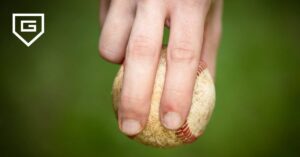
A two-seam fastball – also known as a sinker – is a fastball variation that maintains velocity but incorporates movement. Some pitchers possess both a two-seam fastball and a sinker in their repertoire, each with different types of movement and grips.
Two-seam fastballs typically possess either:
- Hard downward movement or drop
- Horizontal arm-side movement, referred to as “arm-side run” or “tail”
- A combination of both downward and lateral pitch movement
While it’s still one of the fastest pitches in a player’s pitch mix, two-seam fastballs are typically lower in velocity than four-seam fastballs. What you sacrifice in velocity, you gain in movement.
How to grip a two-seam fastball
- Place your index and middle fingers along the narrow seams of the baseball that run parallel at the top of the “horseshoe” seam.
- The “horseshoe” is vertically oriented in a two-seam grip, with the index finger placed along the inside seam and the middle finger along the outside seam.
- Place your thumb beneath the ball – similar to the placement on a four-seam fastball – with your ring and pinky fingers tucked to the outside once again.
- Finger pressure plays a role in the grip and effectiveness of your two-seamer. Increase the pressure of your index finger to create side-spin that causes the ball to drop and/or tail.

Two-seam fastball and sinker grip variations
- Alternatively grip across the seams or perpendicular instead of gripping along or with the seams.
- Grip the wide “horseshoe” seam instead of the narrow seams if it’s more comfortable or to test movement.
- Adjust the placement of your fingers slightly depending on hand size, personal preference, or other factors.
Tips for delivery and release
With pressure on your index finger, focus on pronating your wrist as you release down on the ball. That pronation – with your palm turning toward your arm-side – helps maximize the spin necessary for your ball to “tail” horizontally.
If you’re looking to throw more of a sinker, don’t place as much emphasis on pronation. Focus more on releasing down on the ball.
How to use two-seam fastballs
Because of the movement – either horizontal “tail” or “sinking” downward drop – two-seam fastballs are used to initiate weak contact and ground balls. Aim lower in the zone to try and create ground balls with this pitch. A two-seam fastball can induce a timely double play in situations with one or more runners on base.
Leverage the arm-side run to jam batters that share your dominant hand or tail away from the opposite.
- Ex. A right-handed pitcher wants their two-seamer to tail inside and jam right-handed batters or tail outside and away from left-handed batters.
A two-seam fastball can also be used as a strike out pitch or to fool batters into thinking it’s outside the zone. In this use-case, start your pitch outside of the strike zone and have it tail back in. Think of it as the opposite of the previous example. Instead of using arm-side run to jam batters, start your pitch on the edge of the opposite batters box (off the outer edge of the strike zone) and have it tail back into the strike zone.
- Ex. A right-handed pitcher facing a right-handed hitter starts the pitch on the edge of the left-hand batters box. The batter thinks it’s a fastball outside the zone, until it tails back across the outer-edge and into the strike zone. For a left-handed batter, it looks like the pitch is coming directly at their belt, until it tails back onto the inner-edge of the strike zone.
Cutter

A cutter grip is another fastball variation with late movement and elements of a breaking ball. The ball moves towards the pitcher’s glove side as it reaches the plate. As with a two-seamer, a cutter has slightly lower velocity than a four-seam fastball. It makes up for the loss of velocity with lateral movement.
Depending on the velocity and movement, a cutter can look more like a hard slider than a fastball. If you’re looking for an effective bridge between fastball and breaking ball, a cutter is a great pitch to add to your arsenal.
How to grip a cutter
- From a base fastball grip, move your middle and index fingers closer together and slightly off-center toward the outside of the baseball.
- Place your thumb beneath the ball, with your ring and pinky fingers tucked to the outside once again.
- Put more pressure on your middle finger to initiate spin that causes late glove-side break.
Cutter grip variations
- There are two main approaches to gripping a cutter, either positioning the ball like a four-seam or two-seam grip. Whichever variation you choose, the grip is similar.
- Slightly rotate or offset the ball positioning in your hand to affect the movement or cut.
- Tuck your thumb further underneath the ball to affect the movement.
Tips for delivery and release
Maintain the same motion and arm speed as your fastball. That stands true for all of these baseball pitch grips. To best disguise what you’re throwing, every repetition through your motion should look the same to the batter – whether a four-seam fastball or a knuckleball.
As you release, focus on middle finger pressure and rotate your wrist ever-so-slightly toward your glove side. You want your middle finger to be the last point of contact with the ball. Think of it as throwing a regular four-seam fastball, but the pressure of your middle finger helps initiate a subtle, subconscious wrist rotation.
You don’t want to force wrist rotation – you shouldn’t even think about it. If you twist aggressively or force too much rotation on the ball, you’ll lose velocity and delve into breaking ball territory.
How to use a cutter
Use a cutter for late break away from batters that share your dominant hand, or break inside to batters with the opposite dominant hand.
- Ex. A right-handed pitcher throws a cutter that breaks away from a right-handed batter, or breaks inside to a left-handed batter. And the opposite for left-handed pitchers.
A cutter serves two main purposes:
- When it breaks away from the batter, it forces weak contact at the end of the bat and ground balls.
- When it breaks towards the batter, it jams their hands and can break the bat if using wooden bats.
Because they resemble the same pitch out of the hand, a cutter is a good pitch to keep batters honest with your fastball. This is especially true if batters catch onto your fastball and start to time it. Mix in a cutter and the late break will throw batters off their anticipation.
Changeup

The changeup is one of the most popular pitches in baseball and the first off-speed pitch to introduce young or inexperienced pitchers. Changeups are off-speed pitches that look like a fastball out of the hand but with significantly lower velocity. Because they’re thrown with the same motion as a fastball, changeups are the safest off-speed pitch for young players to use.
Though the difference in velocity is most important, changeups also move. A good changeup grip induces a touch of movement down and off to the arm side. This is often referred to as “fading” or “falling off the table” when describing a changeup’s movement.
How to grip a changeup
There is no “one-size-fits-all” changeup. That’s true about any pitch, but as we delve into off-speed and breaking pitches we’ll see more options for “base” grips or starting points.
No matter the grip you opt for, all changeups require you hold the ball deeper in your hand. The depth – from slightly back in your fingers to all the way in your palm – and grip pressure (firm or loose) varies by player and preference. You can test out different combinations of grip depth and pressure to see how they impact velocity and movement.
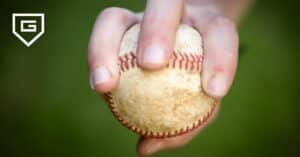
Changeup grip variations
There are four “base” grip variations when it comes to changeups: fastball, five-finger, three-finger, and circle changeup.
- Fastball grip: Grip the ball like a fastball (four-seam or two-seam), but hold the ball tighter and deeper in your hand. This grip is the easiest to learn and most closely resembles your fastball, but the difference in velocity might not be enough to fool batters.
- Five-finger grip: Wrap all five fingers around the ball – either two-seam or four-seam alignment. Position your middle and ring fingers on top of the ball, pinky finger on the outside, index finger on the inside, and thumb on the bottom.
- Three-finger grip: Place your index, middle and ring fingers on the seams. Tuck your thumb underneath and rest your pink on the outside of the ball.
- Circle changeup: Place your middle and ring fingers on the seams – two-seam or four-seam orientation. Rest your pinky on the outside of the ball. Wrap your index finger and thumb on the inside of the ball, creating a circle.
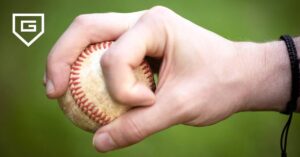
Tips for delivery and release
When throwing a changeup, use the same motion and arm speed as a fastball. As you finish your release you want subtle wrist pronation. Try to have your palm face out toward your arm side. This helps induce the “fading” movement of a changeup.
You don’t want to force too much wrist rotation. That can affect your release, accuracy, and effectiveness. So don’t over-pronate – naturally release with your palm facing your arm side.

How to use a changeup
Sometimes called a “contrast pitch”, changeups disrupt the hitter’s timing after facing fastball velocity. It can be used in any scenario after a fastball to force weak contact or swing and misses.
If a player is sitting on your fastball, mixing in a changeup helps you deceive the batter and keep them honest. That can be the first pitch of an at-bat, after one or more hard hit foul balls, or anytime you notice a player timing your fastball. If you fall behind 1-0 or 2-0, mixing in a changeup can fool a batter that’s anticipating a “get me over” fastball.
Changeups can be used as strikeout pitches, especially to batters of the opposite dominant hand. When properly located on the outside corner of the plate, the combined deception of a fastball lookalike and “fading” movement results in swing and misses as it falls off the table.
Curveball

Curveballs are one of the most popular secondary and off-speed pitches. A curveball is a breaking ball. The rotation is opposite of a fastball – instead of creating backspin, it creates top spin.
The goal is to get forward spin and depth, causing a sharp, downward breaking movement right before reaching home plate. A curveball should move late, hard, down, and potentially across the plate. It’s traditionally referred to as a 12-6 curveball, because the downward break travels in a similar trajectory as twelve o’clock to six o’clock on a clock.
How to grip a curveball
Your curveball’s success relies on your grip. It’s key to master the grip so you get enough break while maintaining control of where you’re throwing. You can orient the ball like a four-seam or a two-seam grip.
- No matter the orientation of the ball, move your index and middle fingers closer together and slightly off-center toward the outside of the ball.
- Rest your thumb on the inside seam underneath the ball, with your ring and pinky fingers tucked on the outside of the ball.
- Apply slight pressure with your middle finger and thumb to squeeze the ball and help maximize spin. Because these fingers are placed on seams, you have a better grip to pull down and achieve proper spin.
Curveball grip variations
An alternative version of the standard curveball is the spiked curve – sometimes referred to as the knuckle curve. The spiked curve can have more dramatic movement, breaking later and harder.
- Use the exact same finger placement as a regular curveball
- Bend your index finger and press the fingertip (or knuckle) into the ball
- Because the spiked curve is an advanced pitch, the exact grip will depend on the pitcher

Tips for delivery and release
You want to get in front of the ball and generate spin with your middle finger. When throwing a fastball, your palm faces the plate at your point of release. For a curveball, you want the top of your middle finger facing the plate.
At your release point, roll your hand forward, snapping your wrist and arm down. Think of it as a shorter, chopping motion to pull down and create spin. This causes the downward drop.
How to use a curveball
Your curveball affects hitters from two core components: change in velocity and movement. As an off-speed pitch, there’s a significant difference in velocity between a fastball and a curveball leading batters to swing too early. The downward movement causes hitters to swing over the top of the ball.
Curveballs can be used at any point. You can throw them early in the count to surprise hitters, disrupt their timing, and get ahead. If a player is sitting on your fastball, mix in the curve to force weak contact or a swing and miss.
When you’re ahead in the count, a curveball is a classic strikeout pitch. Because they’re defending the plate, the late break causes batters to chase outside of the zone. You can also start your curveball outside of the zone — especially if you have horizontal movement on yours – and cause batters to watch it break into the zone for a strikeout looking.
Slurve

A hybrid secondary, off-speed pitch, the slurve bridges a gap between curveballs and sliders. The velocity of a slurve is somewhere between a fastball and a curveball. Combining horizontal and vertical break gives it the signature slider/curveball hybrid.
How to grip a slurve
You grip a slurve the same as your curveball. The difference in movement comes from your motion and release.
Slurve grip variations
As with curveballs and sliders, there’s variation in how you grip the ball.
Tips for delivery and release
Instead of snapping your wrist and pulling down, you want to release at a diagonal motion. This leads to a combination of side spin and top spin.
You still want to rotate your hand, but not as drastic of a snap. Think of it as throwing from the upper arm side to the lower glove side in a diagonal line.
The key is to find a balance between throwing it harder like a slider, releasing with spin like a curveball, and using a diagonal angle to generate break down and out.
How to use a slurve
You can use a slurve in the same way you use a slider or curveball.
Slider
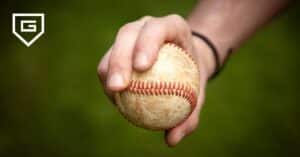
A slider is another common secondary, off speed pitch combining the elements of a fastball and breaking ball. It tends to be faster than a curveball, but has less overall movement. Because it has a faster, sharp break, sliders can be confused as fastballs.
It’s a pitch that bridges that gap between a cutter and a curveball. There’s more movement than a cutter and more velocity than a curveball. Pitchers that struggle with breaking ball command may opt for a slider over a curveball because it’s easier to control.
How to grip a slider
- Place your middle finger on the outside third of the ball, either on the seam or close to it.
- Your index finger sits next to your middle finger, with little to no space between the two.
- Place your thumb on the inside seam underneath the ball, tucking your ring and pinky fingers on the outside of the ball.
- This grip is similar to the curveball grip, but with potentially more space between the index and middle fingers.
- Put a little bit of pressure on your index finger, middle finger, and thumb.
Slider grip variations
Like curveballs, you can throw spiked sliders. Take the same finger placement you’re using and bend your index finger, pressing the fingertip or knuckle into the ball.
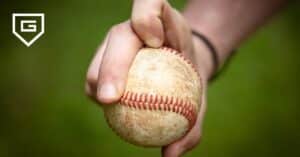
Tips for delivery and release
When releasing a slider, slightly cock your wrist and think of throwing it like a football. That creates “bullet spin” which leads to late side-to-side break.
The most important thing is that your motion and arm speed for a slider remain identical to that of a fastball. That way, you don’t tip off batters.
How to use a slider
Because a slider has velocity and break, it’s used to deceive batters. Like all secondary pitches, sliders force weak contact or swings and misses.
A slider can be used to set up a fastball or switch things up when a batter is timing your fastball. It’s a common strikeout pitch – when batters are behind in the count and protecting the plate, they’re more likely to chase a slider that breaks away late.
Sweeper

A sweeper is a secondary, off-speed pitch closely related to a slider. It has the same grip as a slider, but more total movement and less velocity. Because it’s so closely related, pitchers often possess either a sweeper or a slider.
Due to the lower velocity and spin, a sweeper looks less like a fastball than a slider. The movement of the pitch throws hitters off balance.
How to grip a sweeper
- Hold the baseball with the same grip you use for a slider
- Put more pressure on your middle finger than you would for a slider
Sweeper grip variations
- You can hold a sweeper more like a fastball, but with pressure on your middle finger

Tips for release and delivery
The key to an effective sweeper is your release. It’s here where you create sidespin that causes the “sweeping” horizontal movement.
Your arm speed and motion are identical to a fastball. At release, rotate your hand so your thumb faces you and the back of your hand faces the catcher.
How to use a sweeper
You can use a sweeper the same way you use your other breaking balls. The movement initiates weak contact or swings and misses.
To a batter that shares your dominant hand, the sweeper breaks away and leads to weak contact off the end of the bat. Hitters with opposite dominant hands get jammed inside by a sweeper, again forcing weak contact and potentially breaking the bat (if using wooden bats).
A sweeper is useful in multiple scenarios:
- Early in the count to fool a batter and get ahead
- Mixing it up to throw off a batter that’s timing your fastball
- As a strikeout pitch, getting the batter to chase when they’re behind in the count and protecting the plate
- Force a ground ball with one or more runners on base, inducing a double play
Splitter

A splitter, also called a split-finger fastball, is another secondary, off-speed pitch. Although it’s sometimes called a “fastball”, a splitter has movement and lower velocity. The velocity of a splitter is often between that of a fastball and a changeup.
Splitters offer late, significant movement. The grip creates less spin, causing the ball to break down. Because of the grip, the ball drops suddenly and dramatically as it reaches home plate.
Not every pitcher can throw a splitter. If you have small hands and short fingers, it can be a difficult pitch to throw because you need to get around the ball to have control.
How to grip a splitter
- With the ball oriented like a two-seam fastball, split your middle and index fingers on opposite sides of the ball to form a “V” formation or shape.
- Your index finger sits on the inside (glove side) of the ball with the middle finger on the outside (arm side).
- The amount of separation between fingers depends on the pitcher and personal preference
- The outside of your index finger and inside of your middle finger can touch the outer edge of the seams, or you can split them further apart so neither touches the seams.
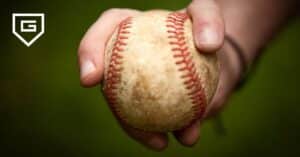
Splitter grip variations
You can modify how far back in your fingers and towards your palm you want to hold the ball. If you go too deep in your hand, you approach “forkball” territory (which we’ll cover in the next section).
Tips for delivery and release
Throw your splitter with the same arm speed, motion, and release as your fastball. Let the grip do the work.
How to use a splitter
Use a splitter the same way you would a changeup or breaking ball. It’s another secondary pitch that looks like a fastball out of the hand but possesses the movement and difference in velocity of an off-speed pitch.
The downward drop can lead batters to swing overtop and miss or initiate weak ground balls.
Forkball

A forkball is similar to a splitter, but with a more dramatic downward break. Forkballs are less common than splitters in a pitcher’s repertoire. The grip is more difficult to master and it’s harder to control.
How to grip a forkball
- Grip the ball the same way you would hold a splitter, but spread the index and middle fingers farther apart.
- The outside of your index finger should be on the inside of the baseball.
- The inside of your middle finger should be on the outside of the baseball.
- Neither finger should touch the laces
- Push the ball far back in your fingers, as far as you feel comfortable

Forkball grip variations
Orient the baseball however you prefer. The only “grip variation” is how far back in your fingers to place the ball. You can also try throwing a forkball with your thumb off the ball.

Tips for release and delivery
Use the same motion and arm speed as your fastball. At your release, you want to snap your wrist to create the downward movement.
How to use a forkball
A forkball is used similar to off-speed or breaking pitches. The dramatic movement and velocity difference throws off the batter’s timing. Like many off-speed pitches, a forkball can be used as a strikeout pitch, to force weak ground balls, or to set up a fastball.
Some pitchers who lack velocity – or those later in their career who experience a dip in peak velocity – use a forkball remain competitive.
Knuckleball

One of the rarest pitches in baseball, a knuckleball serves as a secondary, off-speed type of pitch. Knuckleballs have little-to-no spin, creating a fluttering motion with unpredictable movement.
A knuckleball has a much lower velocity than most other pitches, but the erratic movement makes it extremely difficult to hit. The big part is movement. If your knuckleball doesn’t flutter unpredictably, it’s served up on a silver platter for batters to tee off on.
How to grip a knuckleball
- Hold the ball like a two-seam or four-seam fastball, whatever your preference
- Bend your index and middle fingers, digging your fingernails or fingertips into the surface (either on the seams or just off)
- Don’t grip too tight. You want to have a controlled grip but aren’t trying to push your fingertips or knuckles with any notable force.
Knuckleball grip variations
- Some players have their knuckles on the ball, while others leave their knuckle hovering overtop.
- You can place however many fingers you prefer on the ball. Some pitchers throw a two-finger knuckleball where others use four fingers.

Tips for release and delivery
Use the same motion and arm speed as your fastball. At release, you want all fingers to let go of the ball at the same time. You can think of a “push” forward when releasing, but you don’t want to overthink the motion. Try to keep your wrist stiff up until your release.
How to use a knuckleball
Many knuckleball pitchers use it as their primary pitch. Because of the unpredictable movement, difficulty to master, and lack of wear on the arm, many pitchers who possess a knuckleball use it exclusively.
You can mix a knuckleball in with the rest of your arsenal, using it as you would any breaking pitch.
Baseball Pitch Grip Variations
In all of the baseball pitch grip descriptions, there are variations. That’s because there’s not always a one-size-fits-all approach to pitch grips. When learning a new grip or experimenting with your existing ones, consider testing the following variations for different movements and changes in velocity.
Ball position and tilt
Where you position the ball in your hand can greatly affect the pitch. Many of the base pitch grips start with a four-seam or two-seam position, but you can rotate – or tilt – the ball.

Grip pressure
How much pressure you place on your grip impacts the flight of the ball. If you grip a fastball as tight as possible, it won’t reach maximum velocity.
Grip pressure can be manipulated to change the movement of a pitch. Many of the breaking pitches emphasize pressure on certain fingers to initiate spin. You can test gripping with pressure on different fingers to adjust the break of your pitches.
Thumb position
Your thumb position – or where you place your thumb on the ball – can change the trajectory of a pitch. Some players prefer to keep their thumb underneath the ball for maximum control.
Others like to tuck their thumb completely underneath and off the seam to create more movement. Another option is to rest your thumb on the outside of the baseball.
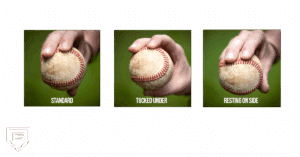
Grip depth
Depth of grip is about comfort and preference. It’s how deep you hold the ball in your fingers or hand. The deeper the grip, the less velocity.
You can test different depths for all baseball pitch grips, especially off-speed and breaking pitches. Some pitchers throw their changeup with the same grip but varying depth to achieve different velocities.
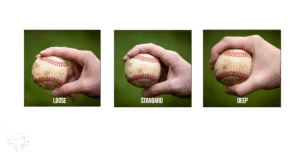
FAQs About Baseball Pitch Grips
What are the different pitch grips in baseball?
Numerous pitch grips exist in baseball, though there are a handful of common grips that most pitchers learn. Typically, common pitch grips are grouped into fastballs, off-speed pitches, and breaking balls.
Some of the most common baseball pitch grips include:
- Four-seam fastball
- Two-seam fastball (or sinker)
- Changeup (or circle changeup)
- Curveball
- Slider
What is the best grip to throw a baseball?
The best grip to throw a baseball is the four-seam grip. This grip keeps the ball on a straight trajectory and gives players the most control. The straight path and ability to control the ball make it easy for fielders to throw accurately to their intended target.
What is the most accurate fastball grip?
The most accurate fastball grip is the four-seam fastball. A four-seam fastball is the most basic fastball grip, with a straight trajectory and full control of the ball. Where other fastballs offer slight movement, a four-seam fastball travels straight toward the intended target. The finger placement offers more control than any other grip.
What is the difference between a slider and a curveball grip?
While curveballs and sliders have similar grips, there are a few differences. The most prominent difference between a curveball and slider grip is that you put less pressure on your middle finger and leave more space between your index and middle fingers.
Your release plays more of an impact than grip in differentiating a slider and curveball. Curveballs involve snapping the wrist and rotating your hand, while a slider involves more of a wrist cock.






